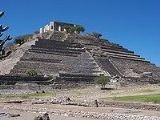
Pyramid of El Pueblito
Encyclopedia

Querétaro
Querétaro officially Estado Libre y Soberano de Querétaro de Arteaga is one of the 31 states which, with the Federal District, comprise the 32 Federal Entities of Mexico. It is divided into 18 municipalities and its capital city is Santiago de Querétaro....
, in the settlement of El Pueblito, seat of the municipality of Corregidora.
This pyramid
Pyramid
A pyramid is a structure whose outer surfaces are triangular and converge at a single point. The base of a pyramid can be trilateral, quadrilateral, or any polygon shape, meaning that a pyramid has at least three triangular surfaces...
, located within the metropolitan area of Santiago de Querétaro
Santiago de Querétaro
Santiago de Querétaro is the capital and largest city of the state of Querétaro, located in central Mexico. It is located 213 km northwest of Mexico City, 96 km southeast of San Miguel de Allende and 200 km south of San Luis Potosí...
, is part of the archaeological zone of El Cerrito. This site had an important population prior to the Spanish conquest of Mexico
Spanish conquest of Mexico
The Spanish conquest of the Aztec Empire was one of the most important campaigns in the Spanish colonization of the Americas. The invasion began in February 1519 and was acclaimed victorious on August 13, 1521, by a coalition army of Spanish conquistadors and Tlaxcalan warriors led by Hernán Cortés...
. During the 1st millennium
1st millennium
File:1st millennium montage.png|From left, clockwise: Depiction of Jesus, the central figure in Christianity; The Colosseum, a landmark of the once Roman Empire; Gunpowder is invented during the latter part of the millennium, in China; Chess, a new board game, takes on popularity across the globe;...
there were several settlements in the Bajío
Bajío
The Bajío is a region of Central Mexico that includes the plains south of the Sierra de Guanajuato, in the state of Guanajuato, as well as parts of the states of Querétaro and Michoacán .In general parlance, it is usually associated with the States of Guanajuato and Querétaro, although it only...
area, this being one of the most important ruins in the central region of Mexico
Mexico
The United Mexican States , commonly known as Mexico , is a federal constitutional republic in North America. It is bordered on the north by the United States; on the south and west by the Pacific Ocean; on the southeast by Guatemala, Belize, and the Caribbean Sea; and on the east by the Gulf of...
.
It is presumed that its history stretches back two thousand years, beginning when the first settlers arrived in the valley of the El Pueblito river, an area suitable for agriculture
Agriculture
Agriculture is the cultivation of animals, plants, fungi and other life forms for food, fiber, and other products used to sustain life. Agriculture was the key implement in the rise of sedentary human civilization, whereby farming of domesticated species created food surpluses that nurtured the...
. Some current settlements that were populated during this era include El Pueblito, Santa Bárbara, La Negreta, El Recodo, El Shindó, El Molinito and La Cueva. The people worked the land, dam
Dam
A dam is a barrier that impounds water or underground streams. Dams generally serve the primary purpose of retaining water, while other structures such as floodgates or levees are used to manage or prevent water flow into specific land regions. Hydropower and pumped-storage hydroelectricity are...
med the river in order to irrigate their fields and opened roads for communication, making El Cerrito the first nucleus of spiritual and political importance in the region.
The pyramid, similar in size to the Pyramid of the Moon in Teotihuacán
Teotihuacán
Teotihuacan – also written Teotihuacán, with a Spanish orthographic accent on the last syllable – is an enormous archaeological site in the Basin of Mexico, just 30 miles northeast of Mexico City, containing some of the largest pyramidal structures built in the pre-Columbian Americas...
, was erected at some time before 1000 AD. Important relics have been found, such as sculptures, tombstones, calendar glyphs and many figurines. For more than a millennium the site was exposed to the climate and negative human intervention, suffering enormously. As late as the twentieth century the area was subject to vandalism and theft: since there was no control over it, visitors could remove whatever they found. It was not until 1995 that Mexico's National Institute of Anthropology and History
National Institute of Anthropology and History
The Instituto Nacional de Antropología e Historia is a Mexican federal government bureau established in 1939 to guarantee the research, preservation, protection, and promotion of the prehistoric, archaeological, anthropological, historical, and paleontological heritage of Mexico...
(Instituto Nacional de Antropología e Historia, INAH) began restoration projects and was able to rescue some articles, which can now be seen in the Regional Museum in Santiago de Querétaro.
In the open space dubbed Plaza de las Esculturas (Place of the Sculptures), works have recovered 13 skulls, 18 jaws and numerous teeth and other bones. They correspond to male individuals of between 18 and 35 years of age.

